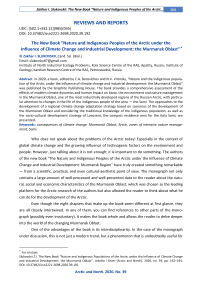The new book “Nature and indigenous populations of the Arctic under the influence of climate change and industrial development: the Murmansk oblast”
Автор: Slukovskiy Zakhar I.
Журнал: Arctic and North @arctic-and-north
Рубрика: Reviews and reports
Статья в выпуске: 39, 2020 года.
Бесплатный доступ
In 2020, a book, edited by E.A. Borovichov and N.V. Vronsky, “Nature and the indigenous population of the Arctic under the influence of climate change and industrial development: the Murmansk Oblast” was published by the Graphite Publishing House. The book provides a comprehensive assessment of the effects of modern climate dynamics and human impact on biota, the environment and nature management in the Murmansk Oblast, one of the most industrially developed regions of the Russian Arctic, with particular attention to changes in the life of the indigenous people of the area - the Sami. The approaches to the development of a regional climate change adaptation strategy based on scenarios of the development of the Murmansk Oblast and considering the traditional knowledge of the indigenous population, as well as the socio-cultural development strategy of Lovozero, the compact residence area for the Kola Sami, are presented.
Consequences of climate change, murmansk oblast, arctic, zones of intensive nature management, sami
Короткий адрес: https://sciup.org/148318400
IDR: 148318400 | УДК: [502.1+332.12](985)(045) | DOI: 10.37482/issn2221-2698.2020.39.192
Текст научной статьи The new book “Nature and indigenous populations of the Arctic under the influence of climate change and industrial development: the Murmansk oblast”
Who does not speak about the problems of the Arctic today! Especially in the context of global climate change and the growing influence of technogenic factors on the environment and people. However, just talking about it is not enough; it is important to do something. The authors of the new book “The Nature and Indigenous Peoples of the Arctic under the Influence of Climate Change and Industrial Development: Murmansk Region” have truly created something remarkable — from a scientific, practical, and even cultural-aesthetic point of view. The monograph not only contains a large amount of well-processed and well-presented data to the reader about the natural, social and economic characteristics of the Murmansk Oblast, which was chosen as the leading platform for the Arctic research of the authors but also allowed the reader to think about what he can do for the development of the Arctic.
Even though the eight chapters that make up the book seem different at first glance, they are all closely intertwined. In any of them, you can find references to other parts of the monograph (possibly even involuntary). It makes the book whole and allows the reader to delve deeper into the world of the changing Murmansk Oblast.
One of the advantages of the book is its interdisciplinarity. In the case of the monograph under discussion, this is not just a modern trend, but a phenomenon that is undoubtedly useful for
science. The problems of climate change and the growing industrialization of the Arctic are discussed at the beginning of the book. It vividly reflected in the following chapters, where the authors talk about vegetation, water resources and the indigenous population of the Murmansk Oblast, but do not just talk, but explain what happened to them in light of global transformations on our planet, incl. a separate corner of the Russian Arctic.
Also, the book is useful for a simple acquaintance with the Murmansk Oblast and all its features. Therefore, the publication will be especially useful for those who live in other regions of Russia and the world and have a poor idea of the Kola North. But even for locals and readers who are well acquainted with the Murmansk Oblast, the monograph contains a lot of useful and new information. E.g., you will find out how many new plant species brought about the development of the region at the beginning of the 20th century, what kind of plants they are, and whether you can meet them while walking in one of the cities of the region. You will learn what types of fishing are relevant for the indigenous people of the modern Murmansk Oblast, why they changed over time, and where to go to see at least a couple of examples from modern life.
The book is beautifully illustrated. It primarily relates to chapters devoted to the description of nature. The diagrams and graphs used to explain complex processes are understandable to a wide range of readers.
At the end of the book, immediately after the list of sources, you can see Appendix 1. It describes the main ideas (regarding relevant international documents) on the interaction of official authorities, representatives of indigenous peoples and society in connection with climate and human-induced changes around the world and the North of Russia.
Summing up, I would like to note that, even having read some of the data presented in the book “Nature and Indigenous Peoples of the Arctic under the Influence of Climate Change and Industrial Development: Murmansk Oblast”, readers will understand better how our northern nature functions, which indigenous peoples live there, and how prepared are they for the various scenarios of planetary change.
The electronic version of the book is available on the IPPES KSC RAS website:
Received on May 04, 2020


